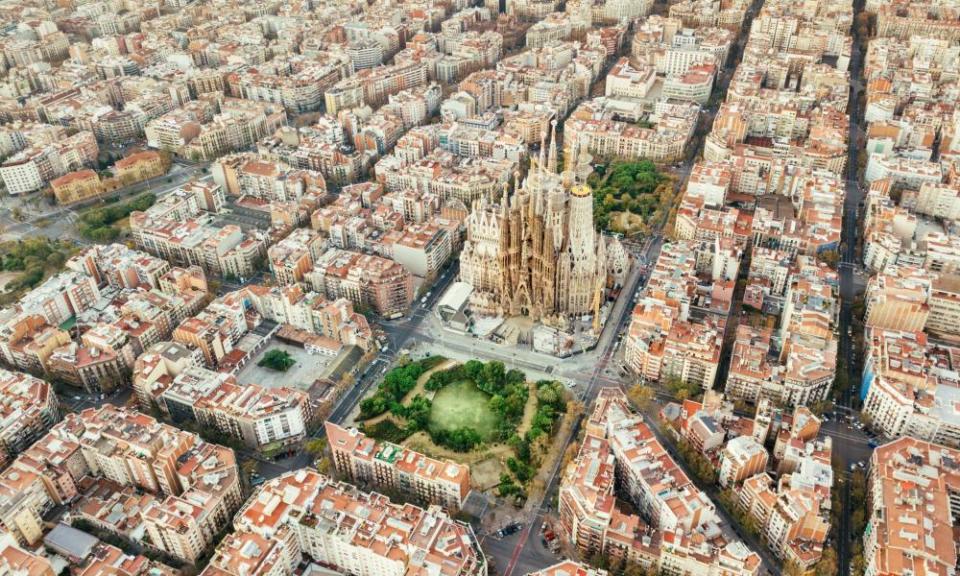Huge star atop Sagrada Família rekindles residents’ complaints
A gigantic 12-pointed star was installed on Monday on one of the main towers of the basilica of the Sagrada Família, Antoni Gaudí’s masterpiece that has been a work in progress since 1882.
But the star is unlikely to brighten the mood of local residents whose lives have been blighted for years by the city’s biggest tourist attraction, which before the pandemic brought 60,000 visitors a day to the area.
Residents associations accuse the religious foundation in charge of the basilica of highhandedness in its dealings with them, and Joan Itxaso and Salvador Barroso, spokespeople for two local groups, are unmoved by the latest addition to the Barcelona skyline.
Barroso described the star, which weighs 5.5 tonnes and measures 7 metres from point to point, as “aesthetically horrible”. It will be illuminated from 8 December, the day Spain celebrates the immaculate conception, along with the tower’s 800 windows.
However, their main anxiety is that the foundation will go ahead with its plan to build an enormous stairway leading up to the basilica’s as-yet-unfinished main entrance which, if fully realised, would entail demolishing three entire city blocks, dislodging about 1,000 families and businesses.
Earlier this month, Itxaso’s association called for all work on the site to be stopped until future building plans had been hammered out in the tripartite meeting between residents, the foundation and the city council. Barroso’s group is taking legal action against the proposed stairway.
Xavier Martínez, director-general of the foundation, said they were open to suggestions about the stairway but added that it was up to the city council to decide whether to include it in its new urban plan.
The council has so far shied away from making a decision and, with elections little more than a year away, it may be reluctant to agree a plan that involves demolishing dozens of homes.
Barroso claims the stairway was devised by Gaudí’s disciples after his death and was not part of the architect’s original plans which were destroyed by anarchists at the outbreak of the Spanish civil war.

Prominent local architects say the recent work cannot be regarded as Gaudí’s, a view shared by Unesco, whose national heritage site listing only covers the part of the basilica completed during the architect’s lifetime.
Martínez disagrees. “We have no doubt that what we are building is the work of Gaudí,” he said.
Since work began 139 years ago, the Sagrada Família has become a byword for unfinished business and the 2026 completion date has been abandoned as a result of the pandemic. Martínez was not willing to speculate on a new completion date.
He said it was only in 2010, the year the basilica was consecrated by Pope Benedict XVI, that they realised that thanks to tourism they might finally have the resources to complete the job, but that was before the pandemic.
At its last press conference, in 2019, the foundation announced income for 2018 and 2019 of €80m (£67m) and €100m respectively, of which approximately €110m was earmarked for construction work.
The remaining €70m was put aside “in case there should be a drop in visitor numbers”, the meeting was told.
Consequently, eyebrows were raised when, at the start of the pandemic, the foundation announced that all work except for the María tower would be suspended until 2024 and most of the workforce was put on furlough until further notice.
Martínez says the €70m “rainy day” fund has been needed to pay the part of the salaries not covered by the Covid furlough scheme as well as site security and other expenses, and that work cannot resume while visitor numbers remain only about a quarter of the 2019 figure.
“Once a year they hold a press conference where they say how much income they’ve received and how they plan to spend it, but it is impossible to verify these figures because nothing is costed,” said Barroso.

in the Eixample neighborhood in Barcelona. Photograph: Orbon Alija/Getty Images
Under an agreement signed between the Spanish government and the Vatican in 1979, the foundation does not have to publish accounts or pay tax. It only has to declare income from the gift shop, while the income from visitors (4.7 million paying on average €15 a head in 2019) is treated as donations.
“We submit our accounts to the [Catholic] church as we are obliged to by law, the lack of public access to the accounts isn’t up to me,” said Martínez, adding that he doubted that greater transparency would satisfy the critics. The church is not obliged to make its accounts public either.
Meanwhile, the stairway issue remains unresolved. Martínez said they were happy to discuss issues with residents “and reach the best solution for everyone”, but that is easier said than done.
“We have to find a solution that meets the needs of the city, not that of the foundation,” Itxaso said.
Joan Josep Omella, the archbishop of Barcelona, described the installation atop the tower dedicated to the Virgin Mary as “an historic moment after a year of darkness and tireless struggle”.

 Yahoo Finance
Yahoo Finance 